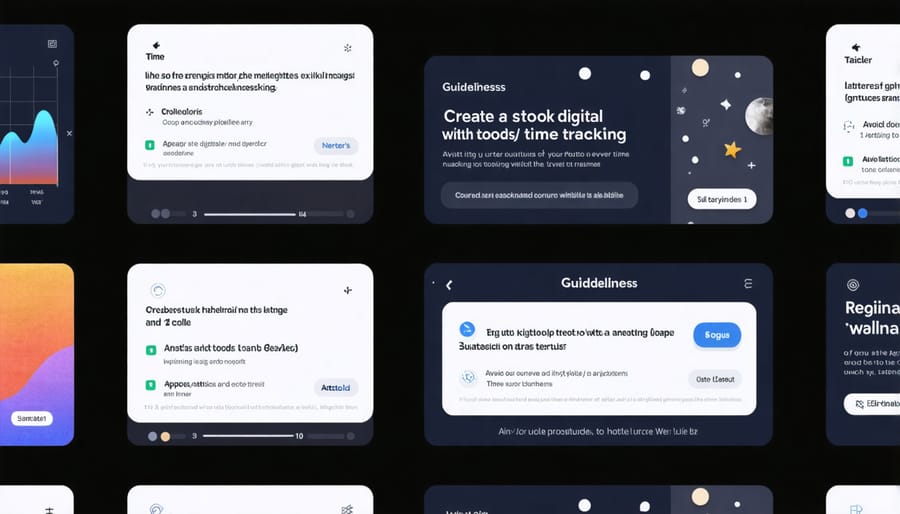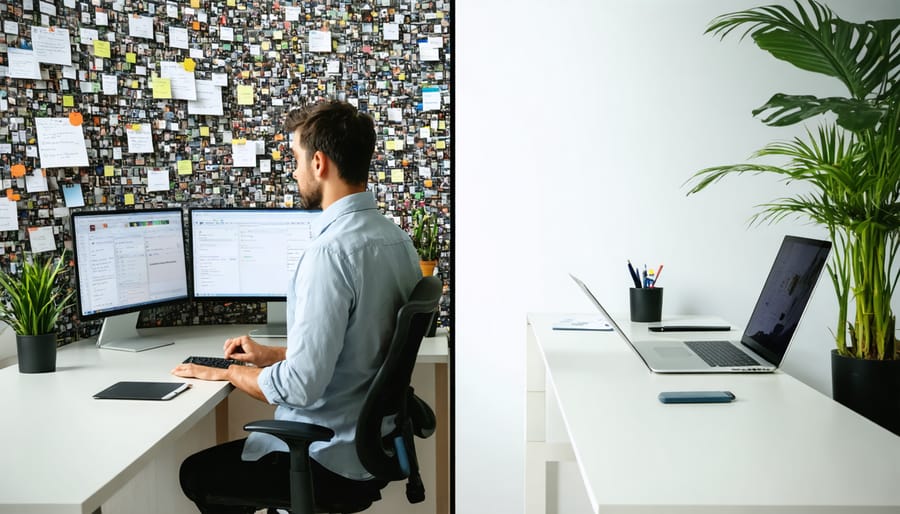Digital well-being isn’t just about screen time—it’s the delicate balance between leveraging technology for enhanced remote work productivity and maintaining our mental, physical, and emotional health in an increasingly connected world. As we navigate the digital landscape, particularly in remote work environments, understanding and managing our relationship with technology has become crucial for overall wellness.
Today’s professionals spend an average of 11 hours daily interacting with digital devices, making digital well-being a cornerstone of modern health. This constant connectivity can either empower or overwhelm us, depending on how mindfully we approach it. Think of digital well-being as your personal framework for using technology in ways that enhance rather than detract from your quality of life.
Whether you’re managing Zoom fatigue, battling notification overload, or struggling to maintain boundaries between work and personal life, digital well-being practices offer practical solutions for thriving in our tech-driven world. By understanding and actively managing our digital habits, we can create a healthier, more balanced relationship with technology while maximizing its benefits for both productivity and personal fulfillment.
What Digital Well-Being Really Means in Remote Work
The Four Pillars of Digital Well-Being
Digital well-being rests on four essential pillars that work together to create a healthy relationship with technology. The first pillar focuses on managing screen time effectively, which involves being mindful of how much time we spend on devices and establishing healthy usage patterns throughout the day.
The second pillar, digital boundaries, helps create clear distinctions between work, personal life, and leisure activities. This includes setting specific times for checking emails, implementing “tech-free” zones at home, and learning to disconnect when needed. These boundaries are crucial for preventing digital burnout and maintaining mental clarity.
Online relationships, the third pillar, emphasizes the quality of our digital interactions. While technology enables us to stay connected with others, it’s important to nurture meaningful connections rather than superficial ones. This means being intentional about online communication, showing empathy in digital spaces, and maintaining authentic relationships both online and offline.
The fourth pillar, tech-life balance, brings everything together by helping us integrate technology in a way that enhances rather than detracts from our daily lives. This involves making conscious choices about technology use, prioritizing face-to-face interactions when possible, and ensuring that digital tools serve our well-being goals rather than override them.
These pillars work together to create a framework for healthy technology use, helping us maintain control over our digital lives while maximizing the benefits that technology offers. By paying attention to each aspect, we can develop a more balanced and mindful approach to our digital interactions.

Signs Your Digital Well-Being Needs Attention
Physical Warning Signs
Prolonged digital device use can lead to several physical warning signs that shouldn’t be ignored. Eye strain, often accompanied by dry eyes, blurred vision, and headaches, is one of the most common symptoms. Many people experience what eye care professionals call “digital eye strain” or “computer vision syndrome” after spending long hours looking at screens.
Poor posture from hunching over devices can result in neck and back pain, commonly known as “tech neck.” This can lead to muscle tension, stiffness, and long-term spinal problems if not addressed. Wrist and hand discomfort, including carpal tunnel syndrome symptoms, may develop from repetitive typing and scrolling motions.
Sleep disturbances are another crucial warning sign. The blue light emitted by digital devices can interfere with your natural sleep-wake cycle, making it harder to fall asleep and affecting sleep quality. You might notice increased fatigue, difficulty concentrating, or feeling unrested even after a full night’s sleep.
These physical symptoms often serve as early warnings that it’s time to reassess and adjust your digital habits for better overall well-being.

Mental Health Indicators
Digital well-being can be significantly impacted by various psychological indicators that emerge from extensive technology use. Common signs include digital fatigue, characterized by persistent headaches, difficulty concentrating, and increased irritability after long screen sessions. Many remote workers experience anxiety related to constant connectivity and the pressure to remain available online.
Another crucial indicator is online meeting burnout, which manifests through emotional exhaustion and reduced engagement during video calls. Learning strategies for preventing video call burnout is essential for maintaining productivity and mental health. Signs of this condition include feeling drained after virtual meetings, experiencing heightened stress before video calls, and having difficulty transitioning between online and offline activities.
Sleep disturbances often signal declining digital wellness, particularly when late-night screen time interferes with natural sleep patterns. Social media comparison and FOMO (Fear of Missing Out) can trigger feelings of inadequacy and anxiety. Watch for signs like compulsive email checking, difficulty disconnecting during personal time, and decreased motivation for non-digital activities. Recognizing these indicators early allows for timely intervention and better management of your digital habits.
Practical Steps to Improve Your Digital Well-Being
Creating Healthy Digital Boundaries
In today’s digital-first world, setting healthy boundaries between work and personal life is essential for your well-being. Start by establishing dedicated spaces and times for work-related digital activities, implementing work-life balance strategies that respect your personal time.
Create specific time blocks for checking work emails and messages, and stick to them. Turn off work-related notifications after hours to prevent the temptation to respond. Consider using separate devices or profiles for work and personal activities – this physical separation can help maintain mental boundaries.
Set clear expectations with colleagues about your availability and response times. It’s perfectly acceptable to communicate that you won’t be responding to messages outside of working hours unless it’s truly urgent.
Establish digital-free zones and times in your home, such as the dinner table or bedroom. This helps create sacred spaces where you can fully disconnect and recharge. Consider implementing a “digital sunset” – a specific time each evening when you stop using devices.
Use technology mindfully by leveraging features like “Do Not Disturb” modes, screen time tracking, and app limits. These tools can help you maintain your boundaries and prevent work from creeping into your personal time. Remember, setting boundaries isn’t about being unavailable – it’s about being present and focused in the right moments.
Essential Digital Wellness Tools
Managing your digital well-being doesn’t have to be complicated, thanks to several built-in tools and apps designed to help you create healthier tech habits. Most smartphones now come with screen time tracking features that provide detailed insights into your daily device usage and allow you to set helpful limits.
For Apple users, Screen Time offers comprehensive monitoring and control options, including app limits and downtime scheduling. Android users can access similar features through Digital Wellbeing, which includes focus mode and bedtime settings to promote better sleep habits.
Several third-party apps can enhance your digital wellness journey. Forest app encourages productivity by letting you plant virtual trees that grow while you stay focused and wither if you leave the app. RescueTime helps track your digital activities across devices and provides detailed productivity reports.
To reduce eye strain and improve sleep quality, consider enabling blue light filters on your devices. Most modern devices include this feature, often called Night Shift or Night Light. For notification management, try apps like Freedom or Focus@Will, which block distracting alerts during designated work periods.
Remember to customize your device’s notification settings. Instead of allowing all alerts to interrupt your day, set up priority notifications for essential communications while muting less urgent ones. This simple adjustment can significantly reduce digital overwhelm and help you maintain better focus throughout your day.

Digital well-being is an essential aspect of our modern lives that deserves our immediate attention and action. As we’ve explored throughout this article, maintaining a healthy relationship with technology involves being mindful of our screen time, setting appropriate boundaries, and implementing practical strategies to protect our physical and mental health.
Remember that achieving digital well-being doesn’t mean completely disconnecting from technology. Instead, it’s about creating a balanced approach that allows you to harness the benefits of digital tools while avoiding their potential drawbacks. Start by implementing small changes, such as establishing device-free meals, creating dedicated offline periods, or using screen time tracking apps to monitor your usage.
Pay attention to warning signs like digital fatigue, decreased productivity, or physical discomfort. These symptoms suggest it’s time to adjust your digital habits. Consider adopting the strategies we’ve discussed, including the 20-20-20 rule for eye health, ergonomic workspace setups, and regular movement breaks.
Most importantly, be patient with yourself as you work toward better digital habits. Every small step counts, whether it’s setting app limits, creating a digital sunset routine, or practicing mindful technology use. Your digital well-being journey is personal, and what works best for you may take time to discover.
Take action today by choosing one or two strategies from this guide and incorporating them into your daily routine. Your future self will thank you for prioritizing your digital wellness.

